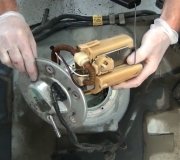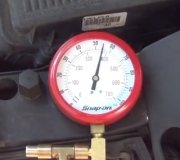First we need to clear up some stuff in my mind. In your first paragraph, nothing really said what the symptom was.
"... The car shut down and she couldn't restart it".
"After reaching her, I tried to start the car, but when I turned the key to the on position, I could not hear the fuel pump... "
"I tried to start the vehicle. Nothing."
"Nothing" is never descriptive. I don't know if nothing worked including dash lights, as though the battery was dead. There was no response from the starter but all the other electrical stuff worked. The starter cranked the engine slowly or normally but the engine didn't start and run. You get the idea.
You tested for voltage to the injectors, ignition coils, and fuel pump, but it sounds like you did that while the engine was running, or at least while the problem wasn't occurring. Of course those circuits will be working then, but now you know you're testing in the right places so you'll be ready when the problem acts up.
The relays are not the problem in this case. I never tested the resistance on one but if they specify 75 ohms, I'd be happy with 50 to 100 ohms. You're only measuring half of the relay, and that's the half that is least likely to fail. If the coil is shorted you'll find close to 0 ohms. That is extremely rare. If it's corroded open, it will read infinite. That's pretty uncommon too because if water gets inside, the contacts will typically corrode first. That's the other half of the relay that's harder to test. If you suspect a relay or just want to eliminate it as a possibility, just swap it with one of the other ones like it. It's not likely you'll have two bad ones at the same time.
As a point of interest, arced or pitted contacts on the relay can cause it to intermittently not switch on, or the contacts could intermittently arc and stick together, and not turn off, but they rarely fail once they are turned on and working. That COULD cause the fuel pump to not run for that first one second when you turn on the ignition switch, but it's very unlikely it would cause the sputtering and stalling while the engine was running.
As another point of interest, GM fuel pumps commonly fail while they're running, leaving you sitting on the side of the road in the middle of nowhere. Chrysler pumps, on the other hand, fail to start up when you start the engine, leaving you sitting in your driveway. They almost never fail once they've started up and you're driving. For that reason, I'm pretty sure the fuel pump is not the cause of the stalling. The one notable exception is if the pickup strainer gets plugged or collapses. The typical symptom is the engine will run fine at highway speed, but stall when the highest volume of fuel is pumped, which is during coasting, but you'll still hear the pump run for one second when you turn on the ignition switch. There could be an intermittent break in the wire going to the pump, but that wouldn't explain the other symptoms, (radiator fan).
Don't assume you're getting spark just because you found 12 volts at the ignition coil pack during cranking. You DO know the circuit responsible for 98 percent of no-starts is working if that voltage is there, but the coil pack could be bad. That's not too common either because there's two individual coils in it, and if one was defective, the engine would still run, but very poorly, on the other two cylinders.
So at this point we don't know if you're losing spark, fuel pressure, or both, and I don't know what "doesn't start" means, but if I had to offer a suggestion, given the erratic behavior of the radiator fan motor coupled with the lack of the fuel pump you heard at one point, I'm leaning toward an alternator problem. Young girls are notoriously inattentive to dash gauges and warning lights, and as long as the car is still moving, they won't notice the voltage dropping or the "battery" warning light is on. Low system voltage will make computers do weird things like cycle relays on and off repeatedly. There are other things that can cause the fuel pump to not run but those things won't affect the radiator fan.
On top of that, it is real common to have intermittent loss of output from the alternator due to worn brushes. I just replaced mine last summer at a cost of nine bucks. The brush assembly can be replaced on a lot of Chrysler models without even removing the alternator from the engine. With a good battery, the engine can still run okay for up to an hour or so, but then, once it stalls, the symptom will be no or slow cranking. Start by measuring the battery voltage with an inexpensive digital voltmeter. It must be 12.6 volts. If it is lower than 12.4 volts, charge it at a slow rate for an hour. If it's 12.2 volts, it's okay but discharged. If you find around 11 volts, it has a shorted cell and must be replaced.
Next, measure the voltage again with the engine running. It must be between 13.75 and 14.75 volts. If it stays the same as when the engine was off, we'll need to take voltage readings on the two smaller terminals on the back of the alternator.
Saturday, April 22nd, 2017 AT 12:48 PM
(Merged)






